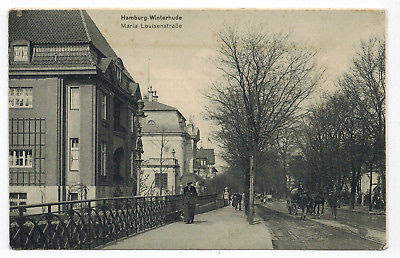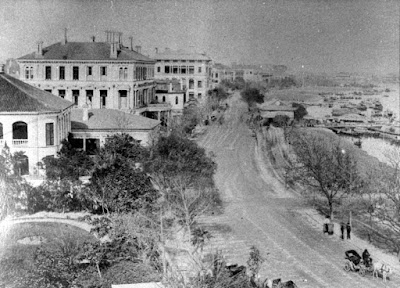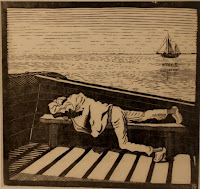Bernard Telge traded (import/export) in metals (iron), colonial ware, machinery for mining and printing, building and contracting of railways and bridges, steam engines, railway locomotives etc.. He also took an interest in coal mines.
 |
| Tientsin (Tianjin) concessions (Austrian bridge) around 1900. |
 |
| Tientsin-Tianjin trading harbor in 1874 |
Somewhere between settling in Shanghai in 1860 and 1870 Bernard Telge will have found a wife (probably in Germany ?) because in 1870 Clara was born in Shanghai. It was mentioned she had a sister or sisters. I have not been able to find anything more about Bernards family so far. For instance the name of his wife and other children. It could be Bernard died in 1898 (that is also when the company was taken over) but that has to be verified.
 |
| Hamburg, Maria Luisenstrasse 1915 |
Bernards brother Rudolph Telge's widow ("Frau Rudolph Telge") is Emma Telge-Oldermann (1834-1911). She lived Uhlandstrasse 38 and was the daughter of former merchant and "Dispacheur" Johannes Olderman (b.1800), Hamburgs official government legal expert on business damages. Judging the size of the dwellings in these posh Hamburg lanes Emma Telge and her sister-in-law seem to have been left very "well-off" by their successful merchant husbands.
Anyway, in 1898 Bernard or his legal representatives left (part of ?) the firm to his nephew Rudolph Telge (1859-1914). As it happens he is one of the sons of Georg Telge (1827-1897) in Hamburg suggesting Bernard had no male successor to his international trading company. It is these small but significant bits of information that help to see the coherence and allowing to rebuild the past.
 |
| Hamburg Uhlandstrasse |
Anyway, in 1898 Bernard or his legal representatives left (part of ?) the firm to his nephew Rudolph Telge (1859-1914). As it happens he is one of the sons of Georg Telge (1827-1897) in Hamburg suggesting Bernard had no male successor to his international trading company. It is these small but significant bits of information that help to see the coherence and allowing to rebuild the past.
-------------
Two of Bernard Telge's associates or partners are particularly intersesting to mention here.
Hermann Schroeter
(born where ? 16-10-1857 - 24-06-1905 Shanghai ?)
Some personal photographs were found and together with some research they tell a dramatic personal story maybe to be continued by readers in future.
Here we see posing elegantly Hermann Schroeter and his wife Emilie Becker photographed in may 1896 in Shanghai in a horse and carriage with a Chinese servant. Emilie Telge-Becker was born (possibly in Lemgo near Detmold) on 11-08-1864. Following the dates with the photographs she is expectant of their first born son Albert (Shanghai 16-10-1896). Unaware of the dramatic events that were to follow the dates with the photo's tell she would die two weeks after she gave birth.
In 1906 Arnold Berg (1874-1939) joined the firm and eventually in 1928 ended up as the owner of the entire company with an office at Hamburg Alsterdamm 7.
 |
| Hamburg: Alsterdamm and Jungfernstieg. |
---------
Hermann Johann Mandl (Edler von Manden)
(Vienna 1856 – 1922 Vienna )
In 1900 Mandl competed in the Paris summer Olympics (the first of its kind and part of the World Fair) on several equestrian disciplines. In 1909 he returned to Vienna with a shipload ("a mountain") of art and treasures and was knighted (“Edler von Manden”).
 |
| Paris 1900 World Exhibition. |
-----------
Readers and passer-by are invited to send additions and all they may know about the Hamburg families of brothers Bernard and Georg Telge helping to create a first short biography of forgotten Hamburg painter Clara Telge.
More to follow soon .....(work & research in progress)
All pictures borrowed freely from the Internet for friendly, educational and non commercial use only.
















































